ARCHAEOLOGICAL SITES IN QUINTANA ROO
México » States » Quintana Roo » Archaeological Sites
Archaeological Sites in QUINTANA ROO
Among the many attractions of Quintana Roo is having access to the vestiges of an ancient culture as fascinating as the Mayan culture. Just a few hours away you can visit several very important sites. The archaeological sites of the Mexican Caribbean can be visited any day of the week between 8:00 a.m. and 5:00 p.m., in some of them there are guides who speak several Languages. If you are passionate about archaeological remains, you can visit some in Cancun, Playa del Carmen, Xcaret and Xel-Há.
Map of Archaeological Sites in QUINTANA ROO
Archaeological Sites in CANCUN

El Rey
San Miguelito
Yamil Lu’um
El Meco
Archaeological Sites in the RIVIERA MAYA
Tulum
Main Town and Hotel Zone in Tulum
Tulúm offers a series of bohemian hotels located from the south of the archeological site to the entrance of Sian Ka ́an Natural Reserve. These hotels blend into the natural surroundings and even use solar energy systems. They give a unique experience of peace and tranquility; in fact many of them have the services of meditation, yoga, temazcal, and massages. You can also explore the best places around Tulum, there are a variety of incredible experiences, such as tours to the jungle and nature reserves, or a tour full of history to the ancient Mayan ruins.
This town is an eclectic mix of European and Mayan in the very best possible way. You may find Mayan huts, as well as sophisticated French restaurants. It’s definitely an experience unlike any other! Tulum is located within a National Park with an area of 664 ha. The park has a wide variety of environments such as mangroves, beaches and a large number of cenotes as: Maya Blue, Naharon, Temple of Doom, Tortuga, Vacaha, Grand Cenote, Abejas, Nohoch Kiin and Carwash, also known as Aktún-Há.
Archaeological Site of Tulum
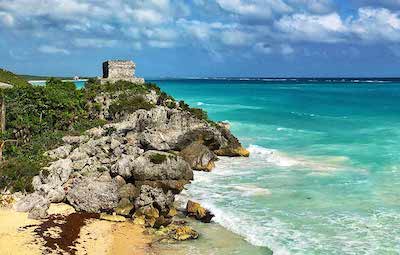
This is one of the most beautiful places in Mexico. Tulum was one of the ports scattered along the coast of Yucatan used by Mayan traders. Tulum was one of the last cities built and inhabited by the Mayan culture; the site was occupied until contact with the Spanish was made in the early 16th century.
This site was formerly known by the name Zama, meaning City of Dawn because it faces the sunrise. It was a ceremonial center, but also an important trade hub. The name Tulum means “Wall” or “Palisade”, and refers to the walls surrounding the site, but it was used in recent times when the place was in ruins.
The archeological site is composed of 70 structures, most of which date from the 12th to the 15th Centuries. Tulúm was a walled fortress and is the only Mayan city built on the coast. Among the most important buildings are: El Castillo (The Castle), The Temple of the Descending God, and The Temple of the Frescoes, used as an observatory with interesting murals.
After exploring Mayan ruins, you can swim and relax on the beautiful white sand beach that lies at the foot of the archaeological site and visit the craft market. There are several surreal cenotes surrounding Tulum. The archaeological site offers night tours with special lighting and audio guides that last about 45 minutes. Schedule: Every day from 8:00 to 17:00 hrs. South to the ruins of Tulum there is a road that leads to the Sian Ka’an Reserve, a UNESCO World Heritage Site!
Learn more about TULUM:
Cobá
Main Town
The small village of Cobá is colorful and has some small hotels, rustic palapas and restaurants offering typical dishes of the region. Some 8 miles north is Punta Laguna, a large inland lake famous for the abundance of spider monkeys of the area. You can combine the tour to Coba with the opportunity to discover and interact with local Mayan communities living in the deep inside the forest.
Arqueological Site of Cobá
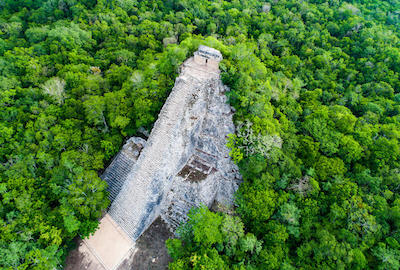
The name Coba means “ash grey water“, since it lies between two lakes and, as with many other sites, the name was probably not its earlier designation. It has a network of 45 elevated stone and plaster roads radiate from the central site to various smaller sites near and far, known as sacbes. Archaeologists estimate that there are 6,500 structures in the area.
Much of the site is still unearthed, giving visitors an eerie “Indiana Jones” experience. It has more sacbe (wide limestone-paved ancient roads) than any site yet discovered. No doubt this is the most important settlement of northeastern Yucatan Peninsula, only comparable in size and importance to Chichén Itzá, his rival and enemy along much of its pre-Hispanic history. The city flourished from 600 to 900 AD, in the classical period and it had an area of more than 80 square kilometers (39 square miles) with about 50 thousand inhabitants.
Among the most important groups are: Coba, consisting of residential complexes, the most notably structure is known as “The Church “, a 25 meter high pyramid. The sacbé 9, the widest on the site, leads to the group of Macanxoc, a ceremonial complex where you can visit a collection of 8 carved stelae, altars and sanctuaries; Nohoch Mul with a 42 meters tall (138 feet) pyramid, the highest Mayan structure in the Yucatan peninsula, at the top of the pyramid there are fantastic views of jungle and surrounding lagoons.
And the Group of Paintings, a large number of stelae (large stone slabs with drawings and glyphs that document major events and historical facts) protected by thatched roofs structures.
The buildings at Coba are somewhat spread out, so you can rent inexpensive bicycle, there are even bikes for kids. They also have bicycle taxis for hire. The archaeological site includes a parking lot and the services of local guides located at the entrance of the site. Schedule: Daily from 8:00 to 18:00 hrs.
Muyil
It is located deep in the jungle 25 kilometers (9.3 miles) south of Tulum on Highway 307, and the blue lagoon adds a new dimension to this Mayan ruins.
There is an observation tower to climb to get an good look over the treetops and enjoy a panoramic view of the lagoon and its connection to the Caribbean Sea. There is also a raise boardwalk that takes you through a marshy jungle littered with small cenotes.
This was one of the earliest and longest inhabited ancient Maya sites in the region. It dates from the late pre-classic era (300 aC-250 DC), and it was inhabited until the arrival of the Spaniards. Because of the proximity to Muyil lagoon the city is thought to have been an important stop in the Maya’s maritime trade route along the coast.
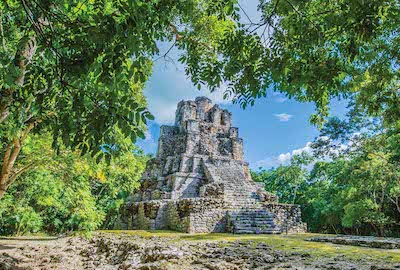
Muyil is the most notable of the pre-Hispanic settlements of the Sian Ka’an Reserve. Here you can admire not only the ancient temples but also can enjoy a unique natural environment. The archaeological site is divided into Group A and Group B.
The first one is considerably extensive and it is conformed by religious and public buildings, platforms, vestiges of housing areas, and a 500-meter long sacbé, extended from the city to the mangrove swamp. In the Group B you will find pyramidal foundations and low platforms.
The most notable structure is the remains of the 17-meter (56-foot) Castillo, with architectural features similar to those found in Petén. Also striking is the small building called Structure 7H3, a double temple with a with a small room, used for ceremonial purposes built over 750 years ago, and in the walls there is still evidence of stucco and wall paintings with colors like red, black and the characteristic Maya blue.
Other important feature is the Temple 8 or Pink Palace, a rectangular building where you can still see evidence of the stucco the Mayans used to cover and decorate their buildings. Schedule: Every day from 8:00 to 17:00 hrs.
Archaeological Sites in the GRAND COSTA MAYA
Twelve centuries ago, according to archaeologists, in the south of Quintana Roo lived near one million inhabitants, which mean three times more than current population. The region was then one of the most important in the Mayan World, and the vestiges of that period confirm that the civilization had large and cosmopolitan cities and had sophisticated ceremonial centers and residential compounds for the ruling groups.
Additionally, the Mayan civilization had developed road networks known as Sacbés, and a water supply system. However, what is striking is its majestic art. This route comprises three archaeological sites very close to each other: Kohunlich, Dzibanche and Kinichna. These sites are an example of the greatness of Mayan Classic Period.
Kohunlich
The former name of the site is unknown. The name Kohunlich is not a Mayan Word, comes from the English Cohoon Ridge, meaning “lomerio de corzos” which refers to the existence of Cohune palms, a characteristic species of the area.
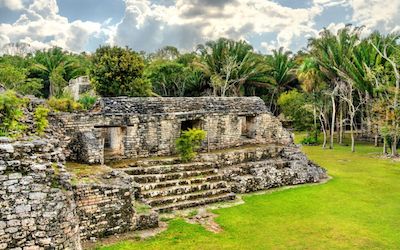
It is located just 70 km west of Chetumal and is a fascinating archaeological site both for its history and for its aesthetic value, beside it is surrounded by a unique natural beauty. It was first settled around 200 BC, although the majority of its most significant buildings were constructed during the early Classic period between 250 and 600 AD, however about 200 of them are still covered with thick vegetation and overgrown by trees. In its golden age, it was a trade linking point for cities in the Yucatán peninsula and the rest of the Mayan cities of Central America.
The most significant peculiarity of this site is the presence of an artificial irrigation system for channeling rainwater. There are 8 groups to explore on the site and among the most important are: The Acropolis, the Palace of the Stelae, the Pixa’an Group and 27 Escalones (27 Steps). The view from the top of this last platform is amazing and provides an overview of the green-carpeted horizon.
The most representative building is the Figurehead Temple under a thatched covering. The pyramid-shaped building is adorned with three-meter-tall masks (8 feet) representing the Maya Sun God, Kinich Ahau, each is slightly different but all are elongated and wear a headdress with a mask on its crest. Five of the original eight masks survive, flanking a central staircase. You can still clamber up the structure to get a close look at these monumental pieces of art, which are in surprisingly good condition with some of the original colors.
By the year 1,200 AD, the site was abandoned, due to an unknown causes. The site also functions as an important wildlife refuge. As it is in the middle of the jungle, you will walk through its paths framed by a huge variety of plants and trees, you can enjoy the flora and fauna of the region. Hours: Daily 8:00 to 17:00 hrs.
Dzibanché
This massive city is scattered over 42 sq. km (16 sq. miles), with several groupings of buildings and plazas though the site is not completely excavated.
It is one of the largest and most important settlements in southern Quintana Roo. During its heyday, it was argued to be one of the largest and powerful settlements competing with other major cities like Calakmul, in the neighboring state of Campeche.
The site is fairly old dating to 200 BC. is a complex composed by four major architectural groups: Dzibanché, Tutil, Lamay and Kinichná. The name of Dzibanché is applied to the main group of structures, located a kilometer and a half east of the entrance. Half way you can see Group Lamay to the west, another archaeological zone that has not been opened to the public because it is still under investigation, and at the far end is Kinichná.

The tour of the Dzibanché group starts with the Platform VI, or Temple of the Lintels. This is a perfect spot to orient yourself for the rest of the site. The structure was built in the Teotihuacán style consisting of an inward-sloping surface or panel called the “talud”, with a panel or structure perpendicular to the ground sitting upon the slope called the “tablero”. This pyramid is topped by a temple with two vaulted galleries and a lintel where you can see Maya calendrical inscriptions, which gave the site its name, since Dzibanché means “writing on wood”.
The path then brings you into Plaza Gann, a huge square platform known as Platform II or Temple of the Cormorant. A burial was found in one of the three vaulted chambers with a number of offerings including a ceramic vase decorated with a cormorant and a jadeite mask with obsidian and shell inlay; the rear corridor, which is narrower and higher, is reinforced at its ends to prevent the collapse of its walls which supported a hollowed-out trapezoidal cresting.
In the plaza there are like a half of dozen of structures, and the most important is the Structure XIII or Temple of the Captives, is of special interest because of the several sculptured risers of its main stairway, representing captured warriors, accompanied by hieroglyphic inscriptions related with military confrontation with Calakmul. Looking across the plaza to the north, we see a similarly plain, stepped platform. It is Platform XVI or the “Temple of the Toucans”. It also is thought to have had a wooden temple on top of the platform.
The Xibalbá Plaza is located northeast of the site and it was the focal point in the ancient city. The Plaza is ringed by North Palace, South Palace and the Platform I or Temple of the Owl, a large building with rounded corners in the style of the Mayan pyramids of the Guatemalan Peten and Belize. Atop of this temple there is a chamber, in which were found the remains of a member of the elite and a rich array of funerary objects, including a rare alabaster statute of a monkey and a carved shell depicting an individual with jade and pyrite inlay. This Mayan site was abandoned around the year 1000.
Oxtankah
Located just twenty-five minutes south of Chetumal, are the remains of one of the most ancient Mayan cities in the Yucatan peninsula. It arose during the Classic era, between 300 and 600 AD.
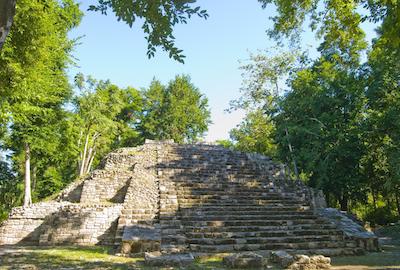
Most of the Oxtankah’s structures you can see today were constructed between the 4th to the 6th centuries, although many of them were modified between the 11th and 16th centuries.
The ruins are clustered around two plazas: Abejas (The Bees) Plaza and the Columnas (Columns) Plaza. In the first plaza you will find a platform with four structures and the remains of what could had been a sacred labyrinth.
In the second plaza stand the remains of a building that seems to have been a palace. Every important structure was covered with stucco, decorated with Mayan glyphs and painted with many colors in its time of glory. There are traces of a chapel, is believed to have been built by the conqueror Alonso de Avila in 1531.
There is a small museum on the site with reproductions of pottery found in this place, as well as drawings of buildings and some maps. Hours: Daily 8:00 to 17:00 hrs.
Kinichná
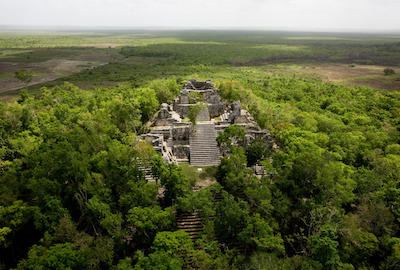
The archaeologists have named this site “House of the Sun” from a stucco element with the representation of the glyph Kin (sun), which is preserved in the back of the Acropolis. The complex consists of a number of smaller palace-type structural units that were believed to have functioned as residences.
At Kinichna, you can climb the spectacular Acropolis, stretching over three levels, each from a different era of history. It was built somewhere between 200 and 600 AD during the early Classic period. The Acropolis is a splendidly proportioned structure; it soars above the plain dwarfing the smaller buildings and terrace that surround it. Stairs lead to palaces and temples on different levels. This temple has preserved in the exterior stucco friezes representing sun motifs. Offerings of jade associated with a burial were found in the upper temple.
The site holds a certain mystery and appeal with a wonderful landscape surrounded by ceiba trees. Hours: Daily 8:00 to 17:00 hrs.
Chacchoben
Chacchoben was established as a collection of small lakeside villages around 300 BC. C. It is the largest settlement detected in the southern lake region of Quintana Roo.
The remains of the archaeological complex cover about 70 hectares. The first structure that can be observed is Temple 24, a great stepped pyramid that reveals, due to its architectural details, a probable relationship with other Mayan cities of Petén as well as the skill of the ancient builders in the good use of concrete between the layers of stone.
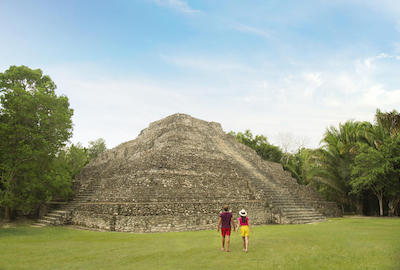
The next major group includes the Great Plaza, which used to be the center of the city. It is divided by a wide public road and the ruins show some old market stalls and some elongated platforms used as residences of the upper class, although today many of them are covered with vegetation. A large number of censers from the last years of occupation have been recovered in the area.
At the southern end of the plaza, a wide staircase leads to the Great Basamento, a very tall artificial platform with the Temple of the Vessels, Temple 1, and some ruins of the foundations of smaller buildings. This structure was an important site for religious rituals.
At the top of these stairs in the Gran Basamento, there are two stone pillars known as Los Gemelos. In one of them there is a drilled hole that focuses the winter solstice sunset on a small area in the Great Plaza. In the same way, the light from the dawn sun is focused through the top of Temple 1, during the summer solstice. Archaeologists believe that there was a statue or stele in these two places and that it was illuminated by the rays of the sun.
Several cups, jugs, bowls and plates were found in the Temple of Vessels. This structure is surrounded by several remains that were probably a residential area.The Ensemble of the Ways has three different parallel rows of low stone platforms and a temple dedicated to the guardian spirits that helped each individual in life. A huge collection of incense burners was discovered inside this temple, which is why archaeologists believe that Chacchoben was an important pilgrimage center, even after the city was abandoned, and that is why between 1200 and 1450 AD, the settlement regained some importance.
When visiting the archaeological site you can enjoy the surrounding landscape, with the presence of toucans and songbirds, sapote and fig trees, white cedars and mahogany trees, a beautiful combination that results in a unique landscape.
Archaeological Sites in COZUMEL
El Cedral
It is the oldest archaeological site on the island but only sparse evidence remains of El Cedral’s past glory, because much of the site was destroyed by conquistadors, but it is the oldest site on the island. Today is the site of the Festival of El Cedral celebration held each May. Commemorating the Day of the Holy Cross, the 150+ year tradition honors the safe passage of 11 founding families who fled the mainland for Cozumel in 1848 during the “Guerra de Castas” (the Caste War).
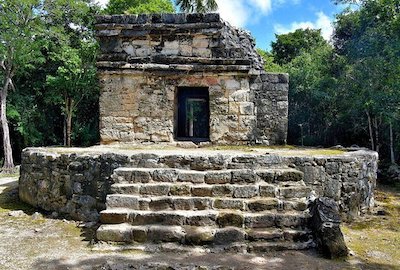
San Gervasio
Marvel at the natural environment and the mysteries of San Gervasio. It is the most important Mayan site in Cozumel’s Island. You can become part of Mayan culture and its mysteries. San Gervasio was a sacred Maya site, plus a strategic site for commerce and politics in the area. It was a sanctuary to Goddess Ixchel and an obligatory visit site for Mayas once in their lifetime. The site includes several architectural complexes connected by a network of sacbes (ancient elevated roads).
The first group, known as Manitas because of the red-colored handprints on the interior walls, was the residence of the halach unik, or the Mayan ruler of Cozumel. It has an outer room and an inner sanctum. As one goes further, you can see a small temple named Nah Chichán or Small House.
The road to the west leads to the “El Álamo” building, that along with “El Palacio” (The Palace), “Los Murales” (The Murals), “El Osario” (The Ossuary) and “Las Pilastras” (The Pilasters) are a group of buildings used as palaces and ceremonial centers.
At the northwest corner of the square there is a Maya arch. This corbelled arch is the entrance of the main religious Sacbé. Walking along this pathway you get to Nohoch Nah or Big House, one of the best preserved buildings in the site, the interior walls still show signs of a red, ochre and blue mural painting, and behind the building there is a cenote.
To the west you will find “Los Murciélagos” (The Bats), the older building in San Gervasio, the compound is made up of several rooms and out-buildings. The largest single structure is Ka’na Nah or Tall House, this structure may have been a temple for Ixchel. Open daily from 8:00 to 15:45 hrs.
El Caracol
The site was occupied during the Late Post classic (AD 1200-1500). It’s believed to have been a lighthouse where Maya used smoke and flames to lead boats to safety. The site has three main structures, two temples and an altar. “El Caracol” (The Snail) is a small, conch-shapedstructurewithopenings at the top acting as whistles to alert Maya to approaching tropical storms and hurricanes. It is located inside the Punta Sur Ecological Reserve. Open daily from 9:00 to 16:00 hrs.
Castillo Real
A 1200-year-old Maya site on the eastern coast of the island. The castillo (castle) comprises a lookout tower, the base of a pyramid, and a temple with two chambers capped by a false arch. The waters here harbor several shipwrecks and it’s a fine spot for snorkeling.
Museums in QUINTANA ROO
Learn more about the Mayan culture in Quintana Roo
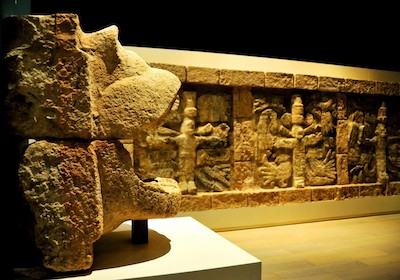
Museo de la Cultura Maya in Chetumal. The displays and models provide a fascinating insight into the Mayan cosmology. The first floor represents the roots of the tree where the Maya underworld named Xibalba reigns. The middle floor is the tree trunk, known as Earth, home to humans and all their trappings. The top floor is the leaves and branches and the 13 heavens of the cosmic world. This distributed around a central courtyard flanked by tall and wide corridors that provide access to the different rooms.
MAYAN ZONE
Located in the heart of the state of Quintana Roo, the Mayan zone is made up of communities dedicated to small-scale farming and inhabited by the descendants of the Mayans. The zone also includes Felipe Carrillo Puerto and Jose Maria Morelos, both have an important roll in the Caste War
of Yucatan in 1847. This region has a rich and unique cultural heritage, and has managed to preserve its established traditions, culture and identity throughout history.
Felipe Carrillo Puerto
It is located about 69 km south of Tulum and more than 90% of the Sian Ka’an Biosphere Reserve is inside this municipality, including three important Maya ceremonial centers. In addition to the traditions and culture you cannot miss:
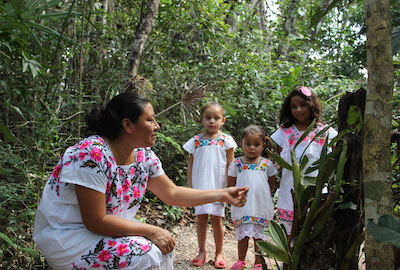
La Casa de la Cultura
The building dates from 1854 and belonged to General Venacio Puc, who plays an important roll in the War of the Castes. Later the place hosted the second government of the Noj Kaj Santa Cruz. Nowadays, the building houses a cultural center that offers workshops, Mayan, dance and guitar lessons, among others; and it also has an exhibition room for all kind of art and is a venue for cultural events.
Pila de los Azotes
It was built during 1864-1870 and was used to punish those who break the law and customs of the Mayan people. When a person was found guilty, he was conducted through the doors of the church, kneeling in front of the cross with the arms extended and received twelve lashes. Then the person had to pray seeking forgiveness. If the offender was a foreigner, he received the same punishment but not in the Church, in the Pile. Adultery was punished with fifty lashes and the aggrieved can poured orange juice into the wounds.
Museo Chan Santa Cruz Balam Nah
The museum has five rooms and offers an exhibit of diverse objects found in the archaeological zones of the Mayan zone. It offers tour guide services. Schedule: Tuesday to Sunday from 9:00. to 15:00 hrs.
Señor
Located just 18 miles (30 km) from Felipe Carrillo Puerto, it is an authentic Mayan community; the inhabitants are willing to open their hearts and homes to visitors. This is a way to learn about the daily life and social customs inherited from the ancient Mayas.
Laguna Azul de Señor
The beautiful lagoon surrounded by lush jungle is only 7 km away from a little town known as “Señor”. The community offers tours to learn more about the local flora and fauna, especially about native medicinal plants. You can rent canoes and practice various water activities.
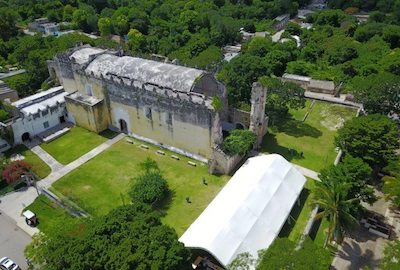
Tihosuco
This town full of culture and traditions is located less than an hour’s drive away from Felipe Carrillo Puerto. In the main plaza you can visit its monumental church and convent of the “Divino niño” (divine child).
If you want to know more about the town history, you can visit the Museo de la Guerra de Castas (Museum of the Caste War in Yucatan) with an exhibit of paintings, sculptures, tools, archeological pieces and documents related to the indigenous movements against the Spanish conquerors.
Ruta de las Iglesias (Route of the Churches)
This route follows the history of Franciscan evangelization during the colonial era. Despite the temples do not have elaborate ornamentation they worth visiting because you can find out about the formidable resistance faced by the Mayans to the conquerors.
The route includes the temple of the Virgin of Guadalupe in Xcabil, the temple of the Virgen of Concepción in Huaymax, the church of San Pedro Apóstol in Sabay and the churches dedicated to San Francisco and the Virgin Mary in Sacalaca. This is a magical journey of discovering true Mayan communities.
José María Morelos
Its history goes back to the pre-Hispanic era when it was inhabited by the indigenous Mayan in the territory of Cochua. Centuries later, many people from all over Mexico, arrived to set up chicle camps in the rainforest to extracted the sap of chicozapote; that is why there is a blend of Christian teachings with indigenous rituals and beliefs in the regional gastronomy and in the celebrations such as: Fiesta de los Reyes Magos (festival of the three Magic Kings), the Feria de la Primavera (Spring Fair) and the Celebración de las Tres Cruces (Celebration of the Three Crosses), during this celebration the people made pilgrimages to pray and plant a ceiba tree, generally considered the Maya tree of life.
More Tourist Attractions in QUINTANA ROO
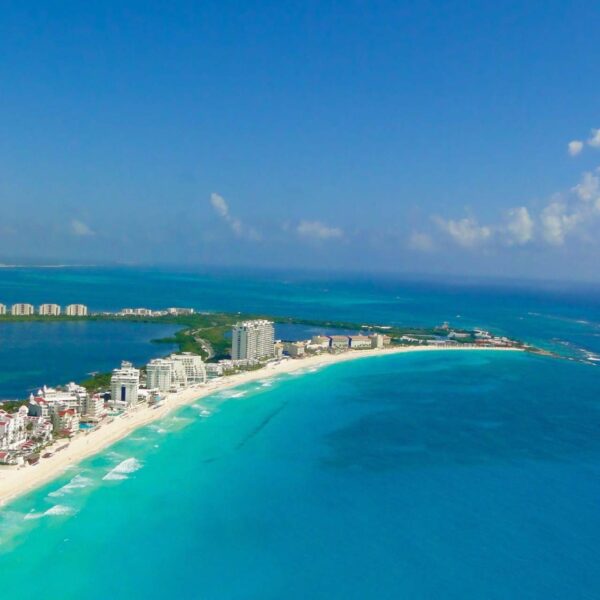
Cancun
Cancun is recognized around the world for its spectacular white sand beaches, its fascinating sea with turquoise blue waters and its unique climate. In addition, it has excellent air and land connectivity, as well as a first-rate hotel infrastructure that places it as one of the best tourist destinations in the world. Year after year Cancun is the destination chosen by national and international visitors thanks to the wide range of attractions and tourist places it offers such as: Mayan culture and history that can be enjoyed in its museums and archaeological sites, water activities, adventure tourism, great variety of gastronomic experiences, spectacular shopping centers as well as seductive entertainment offers for the whole family.… Read More
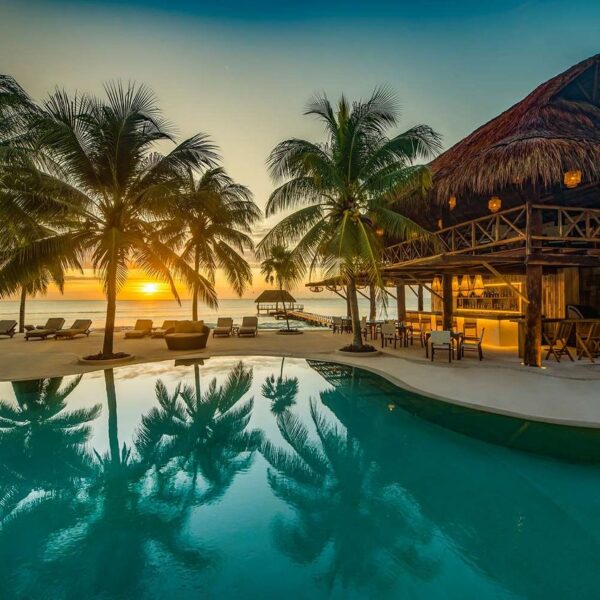
Riviera Maya
Riviera Maya offers wonderful beaches, turquoise waters and fine white sand, archeological sites, picturesque little towns, recreation centers, freshwater lagoons, underwater caves and cenotes, as well as ecological, and food and lodging options ranging from rustic cabins to gleaming condos, five-star hotels, and all inclusive accommodation. Here you can be seduced by an exquisite culinary tour, experiencing the regional cuisine prepared with the inherited Mayan recipes. About the nightlife, Riviera Maya has an exciting and cosmopolitan options with a wide variety of bars and nightclubs along the beach. It is an ideal setting for romance, making it a favorite of those who want a beach wedding or an unforgettable honeymoon.… Read More
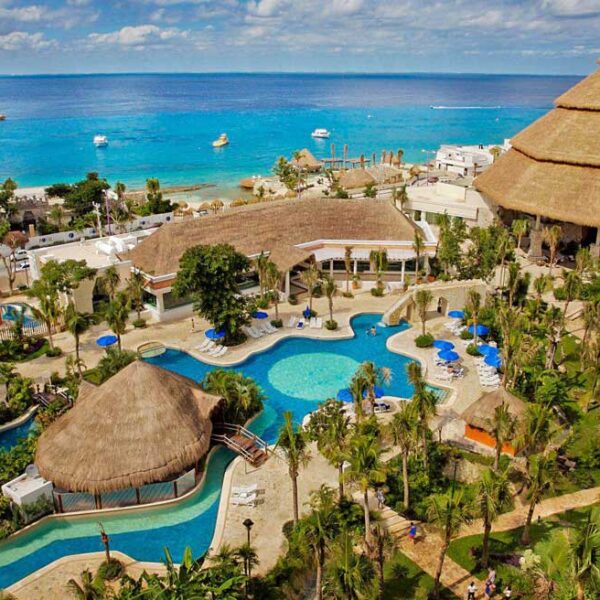
Cozumel Island
With a Mexican heart and a Caribbean soul, Cozumel is a paradise where tradition, flavor and joy come together. You will always find a friendly face and a warm welcome to make your stay an unforgettable one. Cozumel’s mostly undeveloped territory at the center of the island is covered by jungle and swampy lagoons, which are home to tiny mammals and endemic birds that have never left the island. Noteworthy is the Chankanaab National Park, a Cozumel icon, and the Punta Sur Ecological Reserve. This huge protected area at the southern tip of the island includes Punta Celarain and its historical lighthouse, as well as the Colombia Lagoon, a shelter for many of the island’s endemic species, as well as other endangered forms of life, such as marine turtles and their nesting areas.… Read More
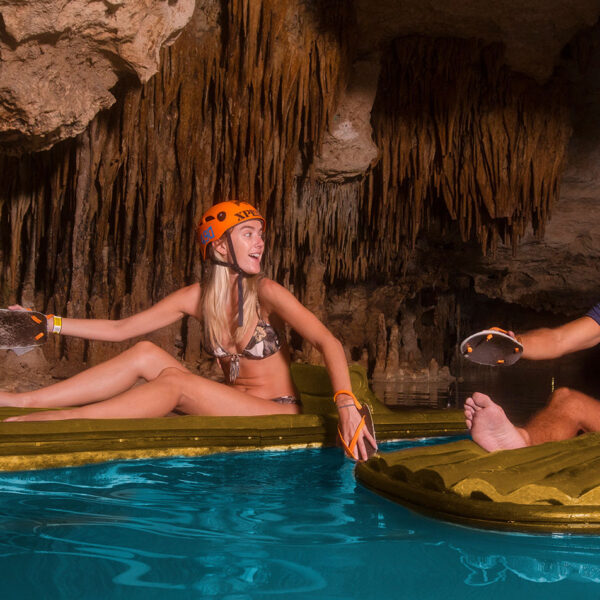
Eco Parks in Quintana Roo
Other options to experience adventure in Quintana Roo are the various natural, thematic, adventure, extreme and aquatic parks where in addition to living exciting and entertaining experiences it is possible to get in touch with nature. Xavage: It is an extreme adventure park with various activities that include a suspended rope circuit, a horizontal zip line, driving an all-terrain vehicle and rafting. Maya Park: Located in the hotel zone of Cancun, it offers a series of activities whose theme is “culture through adventure.” The tour begins with a video that tells the history of the Mayans, continuing with a zip line flight and boat rides through the Nichupté Lagoon. Finally, you will go through the Mayan Path, where you can participate in a Mayan dance and appreciate some elements of this culture.… Read More
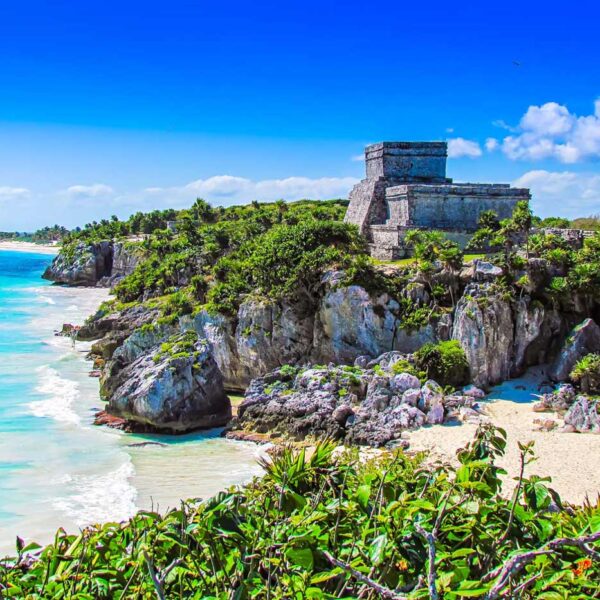
Tulum
The Archaeological Zone of Tulum is a must see and the best example of Mayan charm thanks to its ruins located on the edge of the Caribbean Sea; In addition to being the only archaeological zone that sits on the edge of a cliff, under which is the Playa del Paraíso, one of the best and most beautiful beaches in the Riviera Maya and most likely the most portrayed.… Read More

Water Sports in Cancun
In this destination you will find several marinas that offer water activities, with professional guides and operators who operate excellent fleets. There is an almost unlimited variety of activities, you can rent a jet ski or catamaran, take a tour through the mangroves driving a speedboat, travel in a submarine, snorkel in one of the reefs of Cancun, Cozumel or Puerto Morelos, or else dive in one of the sunken ships that are between Cancun and Isla Mujeres. Cancun has 23 kilometers of beaches of fine white sand and turquoise blue waters, considered among the best and most beautiful in the world. They are ideal for all kinds of water activities.… Read More
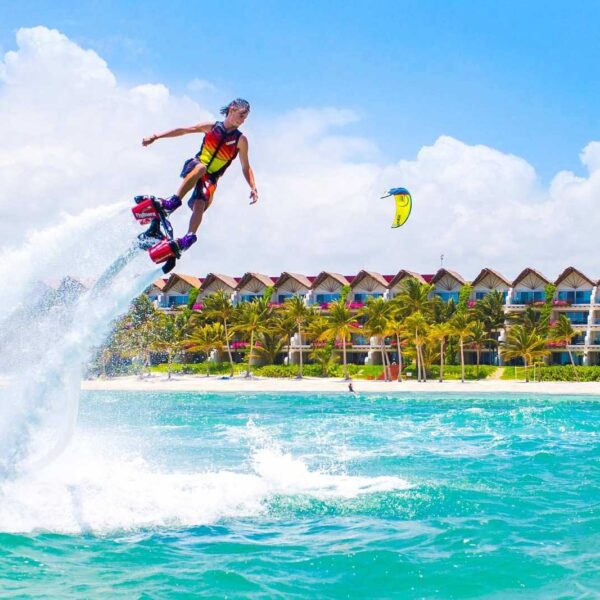
Water Sports in the Riviera Maya
The perfect climate and best weather for Water Sports can be found in the Riviera Maya! Enjoying a day under the bright sun, might be something you find hard to stop doing on your relaxed vacations, just the idea of leaving the comfort of the white sand beaches, but when you do you’re rewarded with clear waters for great visibility and year-round warm water, you won’t resist the idea of practicing great water sports. We offer a great variety of water activities for you to choose from, sports like jet skiing and wave runners, parasailing, snorkeling tours, scuba diving trips, swimming with dolphins and deep sea fishing trips that will get you out on the water and let you be active!… Read More
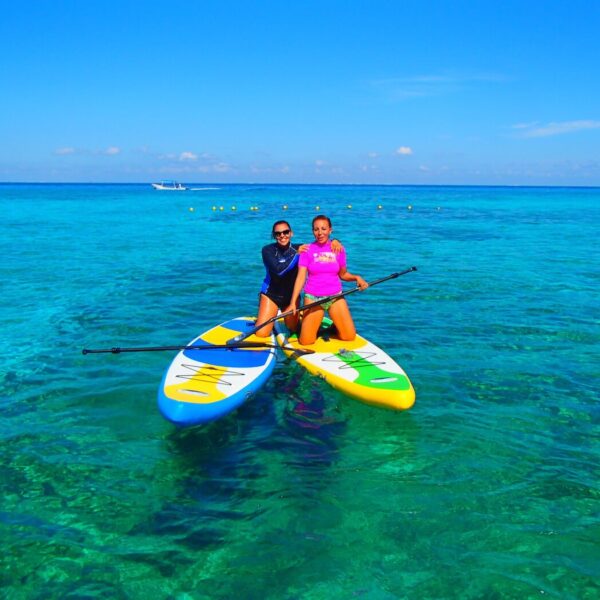
Water Sports in Cozumel
If you are looking for a place with diverse options where each member of the family finds interesting activities, Cozumel is one of the best choices: for the most daring, diving or snorkeling to get to know one of the most important reefs in the world, through kayaking, kite boarding and wind surfing for those who prefer to stay close to the shore, even sport fishing, for family members who prefer to spend a quieter time.… Read More
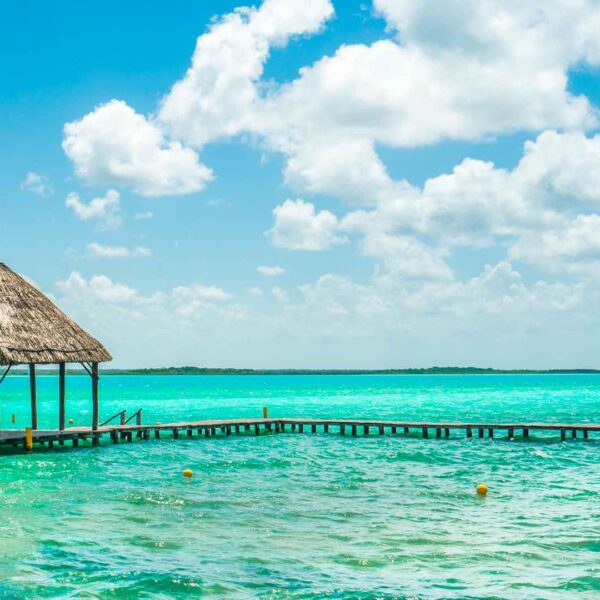
Magical Towns in Quintana Roo
Get to know the Magic Towns of Quintana Roo: Isla Mujeres, Tulum and Bacalar and marvel at their stories, with their archaeological sites, their turquoise waters, ecotourism and adventure activities. Here you will learn about the ancient Mayan civilization, whose essence remains to this day. You will learn about the work of artisans, whose expertise is passed from generation to generation and you will delight in the mixtures of smells and flavors of the exquisite gastronomy of the region.… Read More
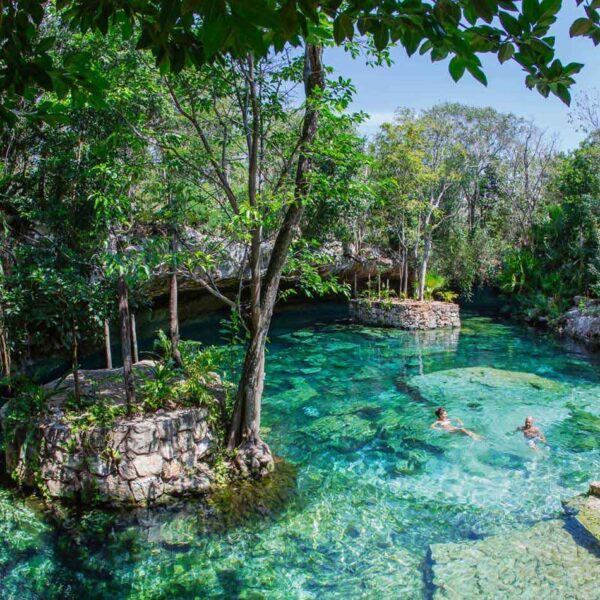
Ecotourism and Adventure in Quintana Roo
In Quintana Roo there are wonderful natural attractions such as the majestic mangroves, the exuberant jungle, the coral reefs, the mystical cenotes and the mysterious underwater caverns. In Cancun and some other destinations in the Mexican Caribbean, it is also possible to admire, live and learn about the conservation of different species of animals, as well as marvel at the diversity of flora characteristic of the area.… Read More
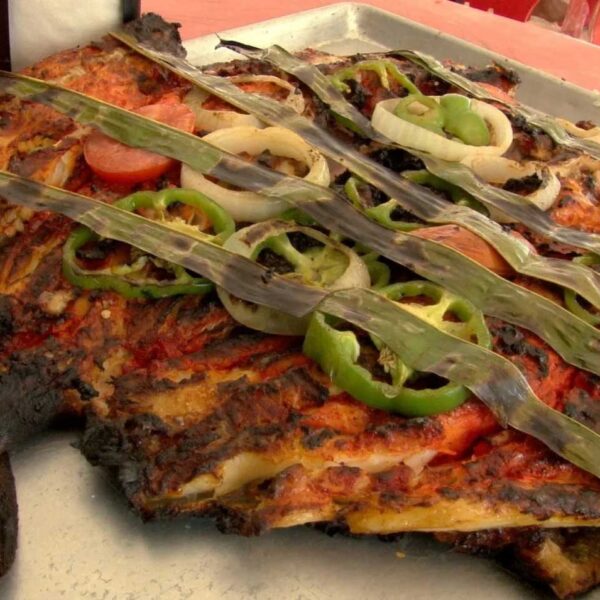
Gastronomy of Quintana Roo
The Gastronomy of Quintana Roo shares several elements with that of Yucatán and Campeche, in which traditional and contemporary cooking techniques are mixed. Although in places like Playa del Carmen and Cancun, where migrants from other countries live, the dishes have been enriched with international flavors. In regional cuisine, ingredients of pre-Hispanic origin are combined with those brought by the Spanish. The dishes of chicken, pork, beef and rabbit meat stewed and seasoned with oregano, purple onion, sour orange, sweet chili, pumpkin seed, tomato, achiote, habanero pepper and coriander stand out among other ingredients.… Read More
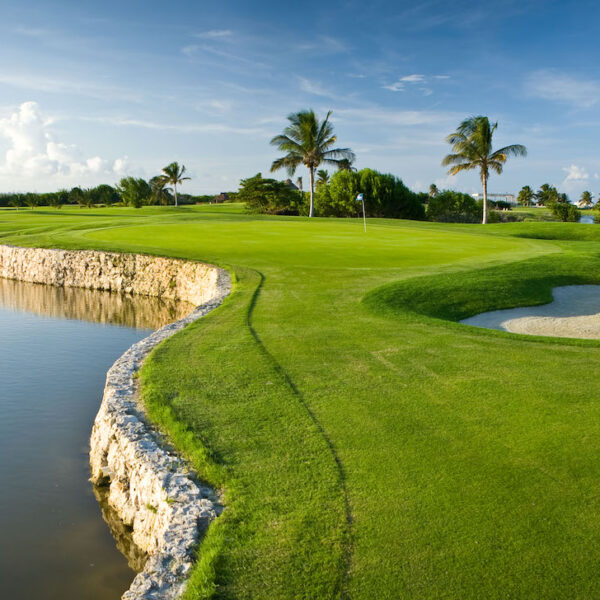
Golf Courses in Quintana Roo
The golf circuit in and around the Mexican Caribbean makes it one of the most competitive destinations both within and beyond our borders. It Offers 15 operating courses, other interesting golf complexes. In an advanced planning stage and the endorsement of international tournaments such as the PGA Tour at Mayakoba, the only PGA event to take place outside the United States and Canada. Cancun is on the verge of becoming México’s new golf leader, with seven courses in Cancun, another seven in La Riviera Maya and one more in Cozumel.
Courses are full-service venues, each with a professional pro shop, well-maintained golf carts, driving range, putting green, Bermuda fairways and greens, caddies, top quality equipment rentals, restaurants, and beverage cart. All the courses are open to the public (some require advance arrangements for access).… Read More
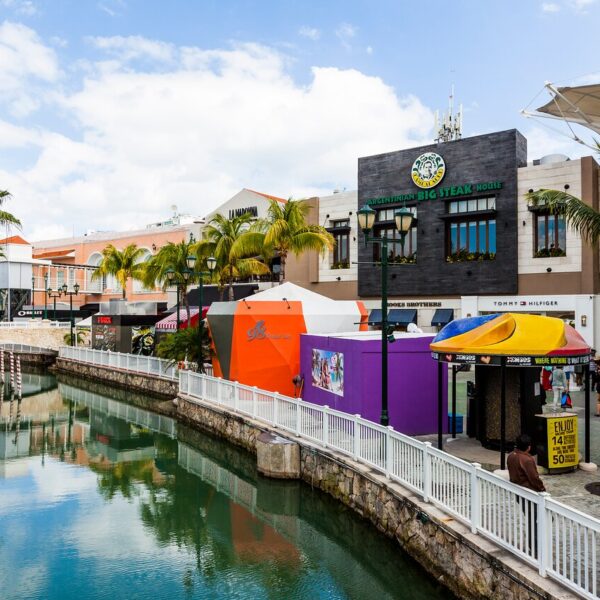
Shopping in Quintana Roo
The shopping experience in Quintana Roo every day becomes more sophisticated and cosmopolitan thanks to the wide variety of options that the destination offers. In addition, it is a duty-free zone for a wide range of items such as perfumery and cosmetics, as well as for wines and spirits, to name a few. There are exclusive and modern shopping centers in the hotel zone and in downtown Cancun with shops and boutiques that allow the visitor to find national and international renowned brands. Each shopping center has a unique architectural style, as well as an attractive range of services and entertainment options for the whole family.… Read More
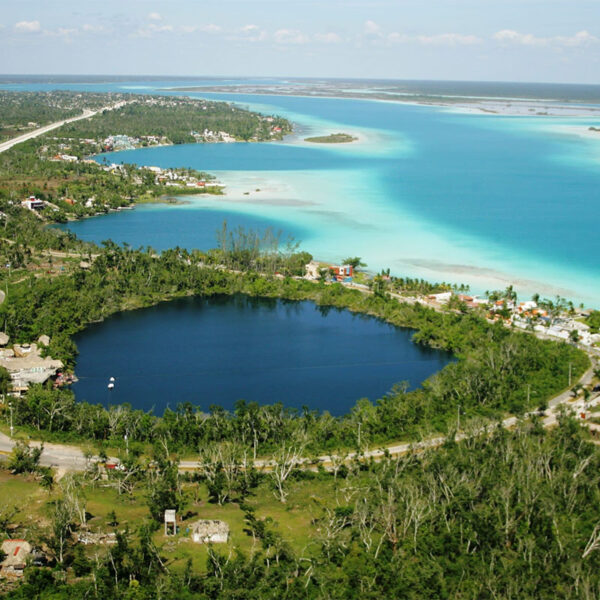
Chetumal
Costa Maya is located on the south of the Quintana Roo state and has many locations to choose from: a typical Caribbean enclave like Chetumal, a Magic Town like Bacalar, beautiful beaches like Mahahual and Xcalak and amazing Mayan sites such as Chacchoben or Kohunlich. Blessed with an unbeatable combination of tropical forest, wetlands, white-sand beaches, coral reefs, abundant wildlife and magnificent archaeological sites, Grand Costa Maya has long been one of Mexico’s best-kept secrets. This is an ideal place for adventure lovers as well as for people who loved Mayan culture, since several communities in here have preserved timeless traditions.… Read More
Guided Tours in QUINTANA ROO
Flights & Hotels in CANCUN
More Tourist Attractions in MEXICO

Archaeological Sites
The Archaeological Zones are the cultural past of every Mexican. You will be amazed at the ambient, nature and the environment that surrounds them. Climbing to the top or being around it will take us back in time to admire every detail. México is a country of culture and traditions, many of which we have inherited from the pre-Hispanic inhabitants of this vast territory, although it is true that there were more settlements in the central and southern part of the country, it is also possible to find some archaeological remains in the north.
… Read More

Gastronomy
The Gastronomy of Mexico has a great diversity of typical dishes, which is why it was recognized by UNESCO as Intangible Heritage of Humanity. The basic and representative ingredients of Mexican dishes are: corn, coriander, chili, beans, piloncillo, nopal and tomato. Mexican cuisine is also characterized by its sauces, which serve as an accompaniment to traditional dishes, prepared based on spices.… Read More

Ecotourism and Adventure
Mexico is one of the best countries for Ecotourism as it has a great variety of flora and fauna, as well as a large number of refuges for extraordinary species. You can enjoy recreational activities of appreciation and knowledge of nature through contact with it, such as: stargazing, observation of natural attractions, wildlife and bird watching. Throughout México there are more than 176 protected natural areas, 5 of them considered by UNESCO as Natural Heritage of Humanity. Just for this and much more, we believe that Mexico is a Paradise for Ecotourism.… Read More

States Of Mexico
Mexico has an incredible diversity of landscapes, where the beauty of its beaches, internationally recognized, stands out. In its vast territory of coasts, there are beaches of unparalleled beauty, and colorful landscapes. A large network of first-class hotels and tourist services is available to visitors to these beaches. Mexico is also mystical places, dotted with archaeological testimonies inherited from its original inhabitants. Monuments made by the Mayas, Aztecs and Toltecs are located in magical landscapes, like lighthouses in an ocean of natural beauty. They offer visitors buildings that tell their history, and museums that collect their cultural heritage. And that keep alive ancestral traditions, in ceremonies and festivals, where you can enjoy cultural activities and entertainment.… Read More

Magical Towns
A Magical Town is a place with symbols and legends, towns with history that in many cases have been the scene of transcendent events for our country, they are places that show the national identity in each of its corners, with a magic that emanates from its attractions ; visiting them is an opportunity to discover the charm of Mexico. The Magical Towns Program contributes to revalue a set of populations in the country that have always been in the collective imagination of the nation and that represent fresh and varied alternatives for national and foreign visitors. A town that through time and in the face of modernity, has conserved, valued and defended its historical, cultural and natural heritage; and manifests it in various expressions through its tangible and intangible heritage. A Magical Town is a town that has unique, symbolic attributes, authentic stories, transcendent events, everyday life, which means a great opportunity for tourist use, taking into account the motivations and needs of travelers.… Read More

Beaches
On the Beaches of Mexico you can immerse yourself in the intense blue ocean of the Pacific bays, sunbathe on the shore of the warm and transparent waves of the Caribbean Sea in Quintana Roo or even rest on the beautiful coasts of the Gulf of Mexico. Mexican beaches hide wonderful secrets for the traveler. By visiting them, in addition to enjoying the excellent climate and water activities, you can discover splendid archaeological sites and interesting colonial cities without traveling long distances.… Read More

Traditions in Mexico
It is practically impossible to make a meticulous, and above all, accurate selection of the places to visit in Mexico. Each place that our country houses is unique and beautiful in its own way. Mexico, with its nearly 2 million km², has a large number of scenarios to offer, as well as endless activities to do. Do not lose your way and enter the places to visit in Mexico. In Mexico, apart from the beaches and its famous archaeological sites, there are many other really interesting sites and activities that you should know. In the surroundings of the main cities you will find places full of culture and tradition, where you can spend relaxing, interesting and fun vacations. On your trip through Mexico you cannot stop obtaining souvenirs, the crafts that are made here are of the highest quality and recognized worldwide. A shopping tour cannot be missed.… Read More

Capital Cities
Folklore, gastronomy, literary culture, art and exhibitions, is what you will find in the capitals of the states of Mexico. To the north, colonial Mexico, Puebla, Guadalajara, Guanajuato, the Sonoran desert and the California peninsula. To the east Veracruz and the gulf. To the west Acapulco, Oaxaca and Tuxtla Gutiérrez. And to the south the Riviera Maya and the pyramids of Chichén-Itzá, Tulúm and Cobá in Yucatán, Palenque in Chiapas, the cenotes, and the Central American jungles.… Read More

